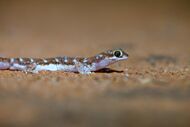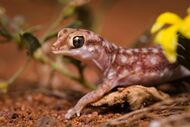Biology:Rhynchoedura
| Rhynchoedura | |
|---|---|

| |
| Rhynchoedura sp. | |
| Scientific classification | |
| Domain: | Eukaryota |
| Kingdom: | Animalia |
| Phylum: | Chordata |
| Class: | Reptilia |
| Order: | Squamata |
| Family: | Diplodactylidae |
| Genus: | Rhynchoedura Günther, 1867 |
Rhynchoedura is a genus of lizards in the family Diplodactylidae. It includes six species,[1] commonly known as beaked geckos, all of which are endemic to the arid zone of the Australia outback.[2]
Members of the genus are terrestrial and nocturnal, sheltering by day in spider burrows. They specialize in eating termites and are most abundant in open, recently burned areas.[3][4][5] They can be characterized by their long bodies and narrow heads with enlarged scales at the tip of the snout. Rhynchoedura species are widespread and occupy a range of dry woodland, shrubland, grassland, and desert environments, and none are currently considered to be at risk of extinction.
The genus was traditionally regarded as monotypic, with the single species Rhynchoedura ornata named by Albert Günther in 1867. A second species was described in 1985, though without widespread recognition at the time. In 2011 an extensive revision sampling the population across Australia found overlooked genetic diversity in the genus and named four new cryptic species. Each Rhynchoedura species is native to a specific perennial river drainage, and active rivers during wet periods of the Neogene could have led to allopatric speciation within the genus.[2]
Species
References
- ↑ Rhynchoedura at the Reptarium.cz Reptile Database. Accessed 16 November 2017.
- ↑ Jump up to: 2.0 2.1 Pepper, M.; Doughty, P.; Hutchinson, M.N.; Scott Keogh, J. (December 2011). "Ancient drainages divide cryptic species in Australia's arid zone: Morphological and multi-gene evidence for four new species of Beaked Geckos (Rhynchoedura)". Molecular Phylogenetics and Evolution 61 (3): 810–822. doi:10.1016/j.ympev.2011.08.012. PMID 21884806.
- ↑ Pianka, Eric R.; Pianka, Helen D. (1976). "Comparative Ecology of Twelve Species of Nocturnal Lizards (Gekkonidae) in the Western Australian Desert". Copeia 1976 (1): 125–142. doi:10.2307/1443783. http://www.zo.utexas.edu/courses/bio373/Oz.Geckos.Copeia.1976.pdf.
- ↑ Letnic, M; Dickman, C. R; Tischler, M. K; Tamayo, B; Beh, C. -L (2004-10-01). "The responses of small mammals and lizards to post-fire succession and rainfall in arid Australia" (in en). Journal of Arid Environments 59 (1): 85–114. doi:10.1016/j.jaridenv.2004.01.014. ISSN 0140-1963. Bibcode: 2004JArEn..59...85L. https://www.researchgate.net/publication/223105895.
- ↑ Pianka, Eric R.; Goodyear, Stephen E. (2012). "Lizard responses to wildfire in arid interior Australia: Long-term experimental data and commonalities with other studies" (in en). Austral Ecology 37 (1): 1–11. doi:10.1111/j.1442-9993.2010.02234.x. ISSN 1442-9993. http://www.zo.utexas.edu/courses/THOC/FireEcologyAustralEcology2012.pdf.
Wikidata ☰ Q3009946 entry
 |



